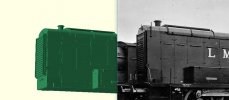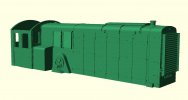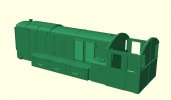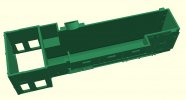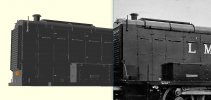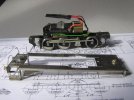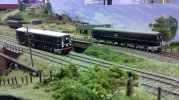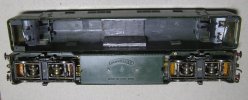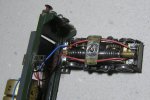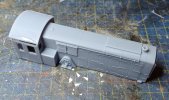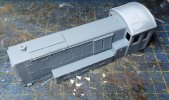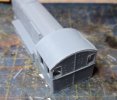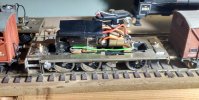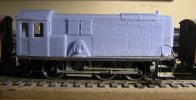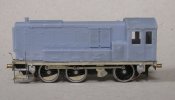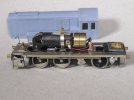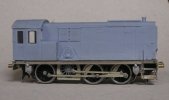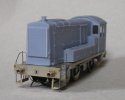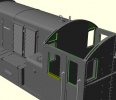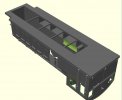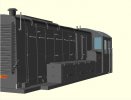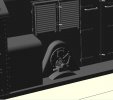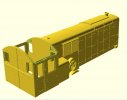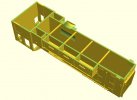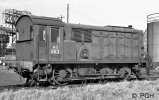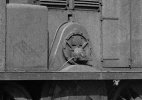Stevers
Western Thunderer
This all came about because I thought we would need a shunter to work a military depot that my son was planning at the time. The depot was on a freelance layout that was set in a real location on the south west corner of Salisbury Plain. I chose this over a nice straightforward Sentinal only because I liked the look of the jackshaft drive that divided the coupled wheels. My kit was purchased at the NEC in about 2006 from the ever helpful Trevor Cousens, who agreed to send me a second chassis etch so that I could fully articulate the coupling rods. This with a view to compensating the chassis on the Sharman principle, and yes, I did contemplate driving the jackshaft, but not for very long! I was sorry to find out somewhat belatedly that Trevor had passed away as I enjoyed my chats with him at exhibitions.
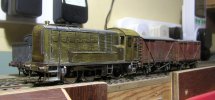
The chassis was built up with High Level hornblocks and gear box, a Mashima can motor and a biggish flywheel. The driven axle is fixed and there's a single beam supporting the compensated axles each side of the jackshaft. The flycrank(?) was laminated up from nickel silver sheet so that I could set the throw to match the wheels which were intended for a J94 Austerity Tank. Opposite the flycrank I used a loco wheel without the steel rim, as those provided in the kit were spoked though clearly the wrong size - more of that anon. I now know that this wheel should not be spoked, and I will fill the spokes in with Milliput when I do the other changes that will be required. Once I'd given the centre driven wheel enough sideplay it has proved to be an excellent runner on curves down to 3' radius. I didn't make the greatest job of building the etched brass body but I think it would have been OK once filled and painted. If I was doing it again I'd definitely scribe the corners of the cab before bending them.
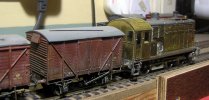
So, to the scale of my problem... With the body fitted it became apparent that it towered over any box van put next to it, so I checked the Roche drawing and realised that the model was in the order of 4mm too high, 2mm too wide and 2.5mm too long. The Roche drawing may have its limitations, but I'd like to think the written dimensions are correct!
At that point in my modelling career it hadn't occured to me that an etched kit of this nature could be quite so far out. My understanding had been that the kit for this English prototype was derived from an H0 kit, but why would this be so? Well, it transpires that because these ten engines all went to the War Dept. they ended up spread far and wide. Two of them on Dutch Railways, and two on Belgian Railways, with the Dutch examples going to the Belgian Railways at some point too. Benelux Modellers have access to etched kits too, and it turns out they have one for this (to us at least) fairly obscure prototype:
Diesellocomotief type 230 later 231.1 - 90023.0 | pb-messingmodelbouw.com
The photograph on the website of the H0 model isn't the best, but it seems to me that the Mercian kit was derived from this H0 kit not least since the bonnet door widths are not quite correct in the same way. Some of the parts provided in the 00 kit are clearly H0, although sometimes there is an alternative 00 part. This disturbing discovery for which there seemed no reasonable fix, caused me to park my model whilst I got on with things that Verwood actually needed and were the right size.
Nevertheless I'm irrationally fond of this fine running model, and a couple of weeks ago it occured to me that I might now have a way to at last put everything right. I'd just 3D modelled the 1860s coaches for the Downton Crash Train using QCAD and OpenSCAD, and I wondered if a loco could be approached in the same way. In principle the running plate with its neatly formed steps could be cut and shut to the correct width and length, with new buffer beams to join the two halves together. Part of the extra height is visible at buffer height, so the amended running plate will need lowering too. This meant that potentially only a completely new superstructure would be required.
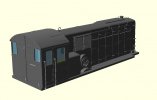
Using the Roche drawing as a starting point and close observation of photographs to try to winkle out any errors in that drawing, I put together this 3D model. An advantage of 3D CAD is that you can manoeuvre the model into the same angle as the reference photo to check the 'look' of something you've changed or added. Needless to say in the absence of proper detailed drawings this is definitely an artists' impression where the finer details are concerned. On the model the roof is a separate part, the light grey parts will be minused out for the final render to leave holes for metal replacements. The glazing pockets are shown in sky blue and translucent, but again will be minused out for the final 3D render. The running plate is there for context and presentation only, and both roof and running plate will be minused for the final 3D render to ensure a good fit and flat bottom respectively.
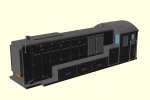
The Roche drawing? In general the rivets shown are only indicative and not a complete set. The side windows on the cab are too deep and have curved corners at the bottom that should not be there. Not on the drawing is an extra slightly hidden bit between the diesel tank and the battery box (shadows cast in both directions on photos). The bonnet angle is not steep enough and the bonnet doors are slightly different widths to the drawings on both sides. The lid on the bonnet behind the chimney is too short too. The Mercian kit has a few issues as well, but the smaller set of errors are not the same.
There are still a few mysteries. There is no photo evidence of access hatches on both sides for what I think are the diesel tanks. Often seen in operational photos is an S shaped pipe curling up from the pimple on the gear drive cover and going into the cab. There's also often something hanging out from the area of that pimple. I suspect that that pimple might be an outside bearing for the gear drive, but that area is so indistinct in my reference photos that it could be anything. Frustratingly whoever built the loco featured on the box had a pretty good idea how that area looked.
Whilst researching all this, I was reminded that the first MRJ Compendium featured the build of a Sayer Chaplin kit for one of these. I also found out that the October 1974 edition of Model Railways has a drawing and feature on these engines. As I changed to MRC in late 1973, that's had to be ordered to see if that can add to my knowledge. Meanwhile an order has gone in for a 3D print of body and roof, and I await its arrival in the post with what now passes for excitement. This is tinged with trepidation, particularly about whether those glazing pockets can be made to work.

The chassis was built up with High Level hornblocks and gear box, a Mashima can motor and a biggish flywheel. The driven axle is fixed and there's a single beam supporting the compensated axles each side of the jackshaft. The flycrank(?) was laminated up from nickel silver sheet so that I could set the throw to match the wheels which were intended for a J94 Austerity Tank. Opposite the flycrank I used a loco wheel without the steel rim, as those provided in the kit were spoked though clearly the wrong size - more of that anon. I now know that this wheel should not be spoked, and I will fill the spokes in with Milliput when I do the other changes that will be required. Once I'd given the centre driven wheel enough sideplay it has proved to be an excellent runner on curves down to 3' radius. I didn't make the greatest job of building the etched brass body but I think it would have been OK once filled and painted. If I was doing it again I'd definitely scribe the corners of the cab before bending them.

So, to the scale of my problem... With the body fitted it became apparent that it towered over any box van put next to it, so I checked the Roche drawing and realised that the model was in the order of 4mm too high, 2mm too wide and 2.5mm too long. The Roche drawing may have its limitations, but I'd like to think the written dimensions are correct!
| Prototype | 4mm Scale (mm) | Mercian Model (mm) | |
|---|---|---|---|
| Height to top of cab | 12'6" | 50 | 53.75 |
| Width of cab | 8'5" | 33.667 | 36 |
| Length of running plate | 28'0" | 112 | 114.5 |
At that point in my modelling career it hadn't occured to me that an etched kit of this nature could be quite so far out. My understanding had been that the kit for this English prototype was derived from an H0 kit, but why would this be so? Well, it transpires that because these ten engines all went to the War Dept. they ended up spread far and wide. Two of them on Dutch Railways, and two on Belgian Railways, with the Dutch examples going to the Belgian Railways at some point too. Benelux Modellers have access to etched kits too, and it turns out they have one for this (to us at least) fairly obscure prototype:
Diesellocomotief type 230 later 231.1 - 90023.0 | pb-messingmodelbouw.com
The photograph on the website of the H0 model isn't the best, but it seems to me that the Mercian kit was derived from this H0 kit not least since the bonnet door widths are not quite correct in the same way. Some of the parts provided in the 00 kit are clearly H0, although sometimes there is an alternative 00 part. This disturbing discovery for which there seemed no reasonable fix, caused me to park my model whilst I got on with things that Verwood actually needed and were the right size.
Nevertheless I'm irrationally fond of this fine running model, and a couple of weeks ago it occured to me that I might now have a way to at last put everything right. I'd just 3D modelled the 1860s coaches for the Downton Crash Train using QCAD and OpenSCAD, and I wondered if a loco could be approached in the same way. In principle the running plate with its neatly formed steps could be cut and shut to the correct width and length, with new buffer beams to join the two halves together. Part of the extra height is visible at buffer height, so the amended running plate will need lowering too. This meant that potentially only a completely new superstructure would be required.

Using the Roche drawing as a starting point and close observation of photographs to try to winkle out any errors in that drawing, I put together this 3D model. An advantage of 3D CAD is that you can manoeuvre the model into the same angle as the reference photo to check the 'look' of something you've changed or added. Needless to say in the absence of proper detailed drawings this is definitely an artists' impression where the finer details are concerned. On the model the roof is a separate part, the light grey parts will be minused out for the final render to leave holes for metal replacements. The glazing pockets are shown in sky blue and translucent, but again will be minused out for the final 3D render. The running plate is there for context and presentation only, and both roof and running plate will be minused for the final 3D render to ensure a good fit and flat bottom respectively.

The Roche drawing? In general the rivets shown are only indicative and not a complete set. The side windows on the cab are too deep and have curved corners at the bottom that should not be there. Not on the drawing is an extra slightly hidden bit between the diesel tank and the battery box (shadows cast in both directions on photos). The bonnet angle is not steep enough and the bonnet doors are slightly different widths to the drawings on both sides. The lid on the bonnet behind the chimney is too short too. The Mercian kit has a few issues as well, but the smaller set of errors are not the same.
There are still a few mysteries. There is no photo evidence of access hatches on both sides for what I think are the diesel tanks. Often seen in operational photos is an S shaped pipe curling up from the pimple on the gear drive cover and going into the cab. There's also often something hanging out from the area of that pimple. I suspect that that pimple might be an outside bearing for the gear drive, but that area is so indistinct in my reference photos that it could be anything. Frustratingly whoever built the loco featured on the box had a pretty good idea how that area looked.
Whilst researching all this, I was reminded that the first MRJ Compendium featured the build of a Sayer Chaplin kit for one of these. I also found out that the October 1974 edition of Model Railways has a drawing and feature on these engines. As I changed to MRC in late 1973, that's had to be ordered to see if that can add to my knowledge. Meanwhile an order has gone in for a 3D print of body and roof, and I await its arrival in the post with what now passes for excitement. This is tinged with trepidation, particularly about whether those glazing pockets can be made to work.
Last edited:

